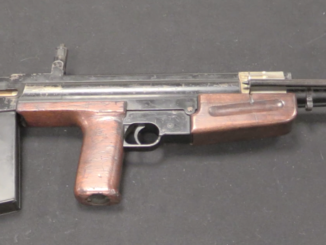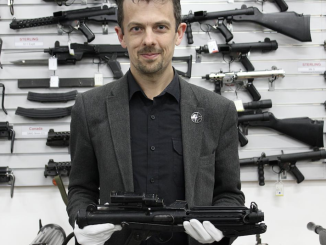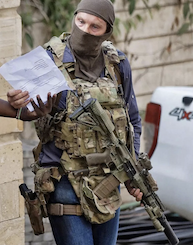The No.5 MkI Enfield, commonly called the “jungle carbine” is nearly the shortest-lived rifle in British military service (second to the Rifle No.9, aka EM-2). Introduced in 1944, they were declared obsolete in 1947 as the result of insoluble accuracy problems. The guns were originally developed from regular No4 Enfield rifles with the goal of producing a shorter and lighter variant for paratroops. This was done by shortening the barrel, adding a flash hider, and making lightening cuts in several places on the barrel and receiver (which were the cause of the problems that doomed the gun).
Not all No.5 rifles produced developed problems, and they were certainly handier than the regular Enfield rifles. They are noted for kicking harder, of course, and this is not really helped by the narrow rubber buttpad they came with (most of which are nice and hard today).




I’m sure that rocket-nozzle flash hider kicked the recoil up a notch as well.
Yet another outstanding viddy, Ian. I had no idea about the machine lightening cuts made to this rifle. I guess a replica would actually be a more accurate rifle then? Also, wasn’t an Australian version made (Lithgow?)?
Lithgow made some experimental versions, but none went into production. They do exist today, but are very rare. Chances are 99.9% that a Lithgow carbine found in the US is a cut-down SMLE.
Ian – if you’ve still got it see if it holds zero. A lot of the wandering zero thing seems to be a bit of a myth (I know quite a lot of people who have or have had them and none reported the problem), pumped up for political reasons since they had millions of No.4’s on strength and why adopt a new bolt-action as we’re moving towards the EM-2 at the time anyway.
I don’t still have it. However, Skennerton’s book on the Enfield goes into detail on the extensive testing done on the question, and it seems to be legit to me.
I have Skennerton’s book, however it doesn’t jive with what I saw and heard from those that owned them. It’s something that is begging to be tested 🙂 Soon I’ll have the facilities to do so, but not the rifle to do it with! I shall have to get me one! He’s also fallen for some strange stuff in the past – the current British 7.62 NATO sniper ammunition is designated L42A1, which he took to suggest that the L42 sniper rifle had been brought back into service (it hadn’t).
Here’s a British thread on the topic that is worth a read, including contributions from some serious collectors: http://www.arrse.co.uk/community/threads/no5-jungle-carbine-wandering-zero.52084/
A friend of mine has a Jungle Carbine, and the zero only wandered after 1000 rounds. The kick wasn’t as bad as I expected. The M70 featherweight 308 was worse.
The “rocket-nozzle flash hider” would not increase recoil. The thrust generated by a rocket motor is the result of the reaction to the accelerated ejection of mass in the form of burned fuel and oxidizer through the throat of the nozzle. The “flared” end after the throat is to control the divergence of the exhaust and other functions. If there were no divergent section it would not result in a decrease of thrust as is shown by the “Aerospike Engine” and Plug Nozzle designs and its variations. The flared addition to the end of the barrel is to serve as a “flash hider.” The principal of the rocket engine is the same that governs recoil in any firearm including air guns … the ejected mass being predominately the projectile and to a lesser degree the propellant gasses/pressurized air. This assumptions of the causative factor of rocket thrust is a prevalent one. For years I believed that the pressure differential between the end of the “bell” of the exhaust flair and that at the upper end of the bell would increase thrust and came to believe otherwise ONLY when tests were run proving otherwise.
Bill Bullock
AARS (American Amateur Rocket Society)
Don’t the muzzle device affects the accuracy?
Further to what Bill has correctly written, the thrust momentum of a rocket, or a jet engine is down to the mass (weight) of what is coming out multiplied by its velocity.
In the case of a jet engine, what comes out the back is very marginally heavier than what went in, but due to the heat it got from the fuel burning, and the tapering jet pipe which actually closes down as it goes towards the rear, what is coming out the back is going much faster.
There is a sweet spot, where the weight of hot air coming out multiplied by its speed is at its maximum,
a larger nozzel might get slightly more weight through but at lower speed, a tighter nozzle might put the gas out slightly faster still, but the weight going through has dropped too much to maintain that peak thrust.
Bill,
That’s incorrect. A divergent nozzle will further accelerate gases that have reached supersonic velocity in the converging section of a given nozzle. This is counter-intuitive, but supersonic fluid flow doesn’t make a great deal of “sense”. In a firearm with supersonic gas coming out of the muzzle after the bullet, a conical flash hider like that will boost the recoil by accelerating those gases.
Still a better rifle than the SA80
On what basis do you make this assertion may I ask…?
Having used both, the L85A2 is in every way a superior weapon in range, accuracy and capacity..
.303 has more oomph. Well I’ve never fired a Jungle carbine but I believe if someone had offered me one as a choice, well…
It looks prettier that’s for sure, and it has more oomph.
Choices, choices.
Depends on the use… A good Jungle Carbine would be better for hunting, I suppose, but as a combat weapon the L85A2, like any modern assault rifle, is so much better that it isn’t even funny. It’s like comparing the M1 Garand to a M1973 Trapdoor. Even the theoretically longer reach of the No.5 would not matter in most real combat situations, since it doesn’t have an optical sight. The L85 has a 20″ barrel, so unlike the US M4 Carbine it should be reasonably effective out to 500 meters.
It would be better with an optic for sure, hey… At least there’s no requirement to forward assist.
I think your “trapdoor” comparison is a bit far fetched, you can put down pretty rapid, fairly accurate fire with this relatively light rifle… Few chaps with Brens in support, well trained troops going forward in support of one another I don’t see it being as such a musket comparison personally.
Mind you I am fond of folding one side of my bush/boonie hat up, in order to appear somewhat dashing so my choice might be influenced by that.
the recoil pads are as hard now as they were when the guns were built, my brother has one our grandfather brought back.
apparently the initial prototypes had a soft pad, then the bureaucrats were worried about the rubber deteriorating, so they made the production guns with a rubber pad that is harder than the wood is. I still think it’s an improvement over the curved brass but-plates, course I don’t mind the kick off the old warhorses anyway.
-cheers
oh, and neither my brother nor I have shot it enough to comment on the zero, grandpa never complained either, though he did take a captured kar 98K into the bush at deer season instead of the Enfield. right now, the bolt for that gun is actually in my fathers SMLE No 4, which he takes to the bush for deer, not sure when that happened, or why.
I’ve seen plenty of the rubber pads deteriorated, especially the ones that were imported from Malaysia. The real reason for the rubber pad was not to lessen recoil, but to keep the lightened gun from sliding off of the shoulder. Same reason for the French Cuirassier M1890 Berthier carbine’s leather buttpad.
A jungle carbine was my 1st deer rifle. Pa paid $25 for it. I used it for 1 season only. Worst rifle I ever shot. To this day you’d have to give me an Enfield before I take one and then only to sell/trade it ASAP.
Bad enough that it wasn’t accurate(bad barrel?) but the safety happened to be bad also. The kick wasn’t bad at all. The jungle carbine was replaced with Remington Mohawk 600 in .308 which weighs 5.5 lbs and was about 2 inches shorter than the Enfield.
Really got to wonder if anyone in the military who decides what to use for a rifle ever has used outside of at range. I’m referring to the No. 4 rifle and other full length rifles. It shouldn’t take more than 6-12 hours in a wooded area to figure out that a full length rifle takes way more energy to carry than something shorter.
Full length bolt action rifles were designed in the late 1880s when infantry tactics were still very different from what they would become during WW1 and later. Long barrels were thought to make volley fire more effective by increasing muzzle velocity. A longer rifle with a greater reach was also generally more effective when used with a bayonet (i.e. used as a spear) on open ground. As ideas about infantry combat and priorities changed, barrels got shorter. The No. 4 Enfield for example was already a short rifle (The S in SMLE comes from “short”). The original 1895 MLE had a 5 inch longer barrel.
Oops, meant “late 1800s”…
I had one of those many years ago. Wish I’d known then what to look for to determine if it was genuine. My main memory is it kicked like a mule, but I often wish I hadn’t sold it.
Interesting that you didn’t mention the lightning cut made in the bolt handle (drilled hole). This would be an indication in most instances that the bolt had been replaced. This is one of the first things I look for when validating originality.
If the bolt matches the receiver, it’s a good indication of originality – but it’s easy to put a hollow bolt into a fake carbine.
All No.5 bolts had the bolt handle hollowed out from the factory. Originally the bolts were serial numbered with an electro-pencil, but during rebuilds it was common to stamp the number as the number often became unreadable after refinishing. Just having the same number doesn’t indicate that it was originally that way. While these carbines failed in British service, the British were more than happy to give them away to their allies. Tons of these went to Malaysia and India, for example.
I did not knew we could remove a Lee Enfield magazine so easily.
You teached me a new thing, Ian.
Big magazines as standard issue for marksmen and assault troops would have been an idea to develop…
There were extended mags during WWi, but according to Skennerton, with the intention of reducing the ammount of mud getting in during subsequent reloads.
The British military bureaucrats were still worried about soldiers wasting ammunition, and even the interwar prototypes of what became the No4, had magazine cut-offs as hommage to the musket era doctrine of single loading and volley fire.
Please remember that pre 1914 nearly all British fighting was done on foot by soldiers carrying their own ammunition working at long distance from their base.
As I know from bitter experience, nobody goes through ammunition like a young, inexperienced and frightened soldier. The cut-off was not added by “British military bureaucrats” but by experienced senior officers who knew the importance of controlling fire, and not wasting ammunition when they could not whistle up an air drop resupply!
Hello
This is only speculation but I wonder if the retention of the magazine cut-off on the interwar period Enfield Rifles had anything to do with the practice of propelling rifle grenades with a blank cartridge. Using a magazine cut-off would reduce the risk of a soldier accidently chambering a live round in the heat of the moment while a grenade was still in the discharger cup.
I doubt it.. Removing the cut off would leave a slot in the side of the receiver that would get filled with debris. It would be a brave or very stupid person to fire a grenade off a No 5!
I just found out in the comments that Cheaper than Dirt has Greek 303 British for $.39 cents apiece. This is great ammo. The most accurate surplus 303 ever loaded by most reports. It is sniper or Match quality ammo. It is totally reloadable with great brass. This ammo has sold for a dollar each for years before the is great ammo shortage and high prices. A word to the wise stock up now if you will be shooting 303 in the future.
Not all of the australian No5’s had the lightning cuts under the receiver (they still had the barrel flutes and cuts on the top of the receiver). I have one and accuracy is similar to a No4 with no wondering zero.
British tests concluded that the flash hider (aka “recoil enhancer) increased recoil by 15% which combined with the lighter weight meant it recoiled over 40% more then a No4. Combined with the small “recoil pad” (aka recoil concentrator) it’s not the most comfortable rifle to shoot. The recoil pad was intended to stop the rifle slipping from the shoulder not reduce recoil.
Another fun at least some of the flash hiders made for the Gibbs rifle company fake jungle carbine rifles were made in New Zealand. They appear to not be of as sturdier construction as the original flash hider.
Dear Ian
Thank you for a simple explanation of what actually caused the much debated wandering zero. This makes me wonder two things. If the SMLE had front locking lug bolt ala Mauser ( yeah, I know – wouldn’t be a SMLE then )would this problem have occurred and how would a No.5 behave with 7.62 x 39 ammo ?
The Jungle Carbine was the first military rifle I ever saw in the Army Navy store down the street where I grew up sometime mid 1950s. Around $20 then. I picked one up in the mid sixties for $25. Did kick worse than my No 1 MK. 3 but not as bad as the Very Short Lee Enfield my friend Carl conjured out of the bent barrel discard I gave him !
The No.5 was the second rifle I purchased when I was in my 20’s. I still have it, but I don’t shoot it much. I have a Type 99 Arisaka that is shortened to similar dimensions as the No.5 and since I reload for both using the same bullets and powder, I was surprised that the Enfield still had more kick than the shortened Arisaka. I think the flash hider and possibly the difference in distance from shoulder to trigger might have something to do with it. If you ever come out to California Ian, you are welcome to compare the two!
It might interest people to know that these rifles saw extensive use by the British army and other Commonwealth forces during the Malayan emergency of 1948-1960 and also during the fight against the Mau-Mau in Kenya which lasted from 1952-1956.
As I understand it production of the No.5 ceased in 1947, but the rifles which had already been manufactured remained in service until the adoption of the SLR, after this they continued to be used by the Malaysian police and native trackers.
In fact if I remember correctly the weapon was still in use during the 1960’s Malaysian confrontation where it was issued to the Border Scouts, an auxiliary force recruited from local tribes in Borneo such as the Iban and Dyaks who provided intelligence on Indonesian troop movements in the border region and also provided trackers and guides for the British forces.
In Malaya and Borneo about three quarters of the small arms engagements occurred at less than 50 yards so I’m guessing that any problems caused by the wandering zero were mitigated and outweighed by the advantages of lighter weight and shorter length given the jungle environment that the British and Commonwealth forces were campaigning in.
Also thanks for posting this video, very interesting and informative
My first surplus rifle, my dad ordered it from The Shotgun News in 1986 or so. The recoil never bothered me and it’s so light and handy.
Having been to Malaysia and seen the hilly terrain and thick vegetation, I would sure want something light like that. The M1 Carbine was also heavily used.
I just bought a No5. BSa serial numbers correspond to 1946 manufacture.
No flash hider or bayonet lug. And who said these kick? Compared to a 270 or 12g shotgun its a pussy.
I’ve had and used my fathers #5 for over 40 years. Great little rifle, its powerful enough to drop a moose in it’s tracks. And as far as wandering zero goes I maybe got a faulty one because it will shoot the heads off rabbits all day long. Still take it along as backup every hunting trip. Appreciate your videos, have a 1905 Ross that I’m going to take to the hills now too after watching your detailed reference to proper bolt alignmet. was my Grandfather’s favorite rifle, I was always leery of it because of the possible myths, Thanks.
Hey Ian,
I found this cool smle Mauser prototype thing on gun broker. Looks like something you would like.
http://www.gunbroker.com/item/565188920